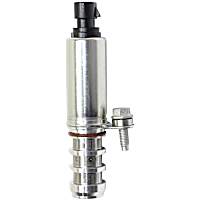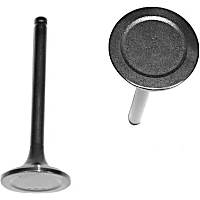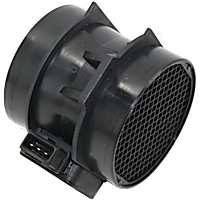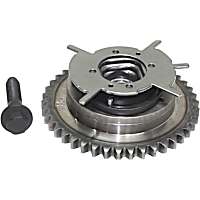The P0011 is a generic OBD-II code, which means it is common across all manufacturers. But more specifically, this specific fault code can be triggered in vehicles with variable camshaft timing, also known as variable valve timing.
Read our guide below to learn more about this error code and to find out how to address it.
What Does the Code P0011 Mean?
A large percentage of today’s vehicles use engines with Variable Valve Timing. Hot Rodders would, for years, alter the valve timing a few degrees to enhance engine performance, but it was largely done in a static way – using a degree-marked cam gear set the valve timing slightly out of spec for optimum performance.
Variable Valve Timing systems have the cam gear designed so that the relationship between the cam gear and the camshaft can be changed “on the fly,” so to speak, i.e, while the engine is under load and the vehicle is being driven.
Some of the earliest VVT systems were on mid-90s Ford Contours and Mazda 626 4 cylinder engines, which would alter the exhaust valve timing to close the exhaust valves early while the engine was under load, allowing some of the inert exhaust gas to remain in the combustion chamber. This effectively reduced NOx emissions and eliminated the need for EGR.
But not long after that, variable intake valve timing began to be used to enhance the engine’s power curve, and it very rapidly became the order of things. Most engines are equipped with VVT today.

How Does Variable Valve Timing Work
The way VVT works is that the ECM/PCM closely monitors the cam/crank timing and uses an oil control solenoid to manipulate the relationship between the cam gear(s) and the camshaft(s) according to predetermined algorithms. The engine controller obviously monitors the cam and crank sensors (CMP and CKP), but also the Mass Airflow Sensor (MAF), the Throttle Position Sensor (TPS), the Engine Coolant Sensor (ECT), and the Vehicle Speed.
Using those inputs along with its programming, the ECM/PCM determines the optimum intake camshaft timing for a given engine temperature, throttle angle, engine load, and speed. Comparing the Cam and Crank sensors, the ECM/PCM continuously works to maintain the target Camshaft Angle. If the target can’t be met, a DTC is stored.
Different manufacturers have slightly different criteria for when this code is set, but a P0011 code points to an Advanced Camshaft Timing condition that won’t respond to PCM commands. If the Engine Computer (ECM/PCM) notices that the cam timing is too far advanced and attempts to set a target to correct that incorrect angle but the Cam and Crank sensors indicate the angle didn’t correct or didn’t correct fast enough, the P0011 code is triggered on bank 1. Every engine has a bank 1. But on engines with 2 banks, (V engines) this condition on bank 2 will store a P0012 code. Remember, bank 1 is always the side where the number 1 cylinder is housed. This is true even on four cylinder inline engines.
If the Engine Computer (ECM/PCM) notices that the cam timing is too far advanced and attempts to set a target to correct that incorrect angle but the Cam and Crank sensors indicate the angle didn’t correct or didn’t correct fast enough, the P0011 code is triggered on bank 1. Every engine has a bank 1. But on engines with 2 banks, (V engines) this condition on bank 2 will store a P0012 code. Remember, bank 1 is always the side where the number 1 cylinder is housed. This is true even on four cylinder inline engines.
–Richard McCuistian, ASE Certified Master Automobile Technician
The opposite codes (Retarded Camshaft Timing) are P0012 and P0022 respectively.
Again, the P0011 DTC) stands for “A” Camshaft Position Timing Over Advanced or System Performance Bank 1. The code indicates that the ECM/PCM has been unable to correct a detected difference in the desired camshaft position angle and the actual camshaft position angle. Its programming has it reaching for a target that the cam and crank sensors indicate that it can’t achieve.
What about the “A” and Bank 1 portions of the code on some vehicles? Well, “A” typically refers to the intake camshaft in a straight or inline overhead camshaft engine. On the other hand, if the engine uses a V configuration, the “A” usually refers to the intake camshaft on bank 1.
What is Variable Valve Timing?
The ECM/PCM operates an oil control solenoid that supplies engine oil to each actuator (one per bank), which in turn, modifies the camshaft position angle, thereby adjusting valve timing. The actuator is usually a special gear with vanes so that oil pressure delivered to the vane chambers will change the relationship between the gear and the camshaft it is driving. Typically, the actuators will be spring loaded to their default position and will return when the solenoid stops delivering pressure to the vanes. There are variations among different makes, so be aware that not all actuators work the same.
It’s worth noting that different automakers refer to the VVT system, as well as the individual VVT components, by different names. Toyota, for example, calls its VVT system, Variable Valve Timing with intelligence (VVT-i); Ford calls its system Twin Independent Variable Camshaft Timing (Ti-VCT).
Also, unlike most other automakers, Ford refers to camshaft actuators as camshaft “phasers.”

What are the Possible Causes of the P0011 Code?
Many different problems can trigger code P0011. Some of the common issues include:
- Faulty camshaft actuator (aka phaser)
- Failed VVT solenoid (aka oil control valve)
- Circuit issues (e.g., damaged wiring, loose connections)
- Damaged timing components (e.g., a stretched timing chain or broken guide)
- Low engine oil level
- Oil contamination or buildup causing the VVT oil flow control valve to stick
- Issues with the PCM, such as software in need of an update
Although P0011 sounds a bit complicated, it can easily be triggered by a low oil level. So, the fix isn’t always an extensive engine repair.

What are the Common Symptoms of the P0011 Code?
If your vehicle is experiencing error code P011, you may observe one or more of the following symptoms:
- Illuminated Check Engine Light
- Engine stalling
- Poor idling
- Difficulty in starting the engine
- Poor fuel economy
- Engine misfire
- Failed emission test
- Rattling noise from the engine
How to Diagnose the P0011 Code
When it comes to the proper diagnosis of OBD-II codes, you may want to leave it to the professionals. But if you’re pretty handy and have the right tools on hand, you can check out the videos below.
Keep in mind that it can be difficult to diagnose and pinpoint the exact cause of most OBD-II codes, as they can have numerous possible causes. Here are some tutorials to help guide you as you diagnose your P0011 error code:
How to Fix the P0011 Code
Disclaimer: Due to the wide variability in vehicle makes and models, as well as other factors, the following information must not be construed as complete or the only definitive way to address a particular issue. Instead, the following content merely attempts to give you a better idea of what a do-it-yourself approach to the issue might involve. You are encouraged to find more technical resources regarding the subject or take your vehicle to a professional technician for the best results.
As with most OBD-II trouble codes, you’re not going to find a “magic bullet” fix for a P0011. This is because all vehicles are different, and not every fix is universal. It’s also worth mentioning that there are a variety of possible causes, which means there are different avenues of repair.
However, even if there are no universal fixes, there are still methods worth attempting if you need to address a P0011 code.
For example, there’s a chance there might be something wrong with your oil or oil filter. This means replacing these could potentially fix the error. Alternatively, there could be something wrong with the camshaft oil control valve.
Here are some simple fixes you could use to try and resolve a P0011:
Change Your Oil and Oil Filter
Vehicles with oil filters that are clogged from using oil that’s too thick can trigger a P0011. Fortunately, changing the oil and oil filter of your vehicle is a relatively simple procedure that you can do at home.
Of course, you could always hire a mechanic to do it for you, but if you’re keen on learning how to do it by yourself then follow these simple steps.
- Park your vehicle on a flat and even surface that’s safe and far from other cars.
- Raise your vehicle with floor jacks to keep it up and away from the ground.
- Remove the drain plug of your vehicle and drain it of all its oil.
- Replug your vehicle’s drain plug after draining the oil.
- Place the oil pan below the oil filter to catch any excess oil.
- Remove your old oil filter and let the oil drip into the oil pan.
- Clean the O-ring and grease it up with clean oil to prevent binding.
- Install the new oil filter.
- Fill your vehicle with newer, cleaner oil with the proper viscosity according to your engine’s specifications.
- Run your vehicle’s engine and keep an eye out for any oil leaks.
Replace the Camshaft Oil Control Valve/VVT Solenoid
Engine code P0011 can also be triggered when the camshaft timing is off. This code may mean it might be time to replace the camshaft oil control valve, also known as the VVT solenoid.
Here’s how to do it:
- Park your vehicle and turn off the engine.
- Open the hood of your vehicle.
- Disconnect the battery of your vehicle.
- Search for the camshaft oil control valve/VVT solenoid in your vehicle. The location varies depending on the model, but it is normally located at the front of the engine.
- Remove the mounting bolts of the VVT solenoid and keep them someplace safe.
- Disconnect and remove your old VVT solenoid.
- Lubricate your replacement solenoid with lithium grease.
- Insert and install the replacement solenoid.
- Secure the replacement solenoid by installing the mounting bolts again.
- Close the hood of your vehicle and go for a test drive.
Other Notes About Code P0011
Fixing the P0011 code could sometimes be as simple as topping off your engine oil. However, severe cases may cost you thousands of dollars depending on which component is causing the problem.
An oil change ranges from $20 to $60. Replacing the oil control valve or VVT control solenoid, on the other hand, costs around $400, and an engine overhaul or a replacement engine will cost anywhere between $2,500 to $4,000.
How To Find Quality Replacement Parts To Fix Your P0011 Code
In some cases, a simple oil change is all you need to get rid of the P0011 code. However, if the culprit behind the DTC is a faulty camshaft actuator, a bad oil control valve, or a damaged timing chain, then you’ll have to spend a little bit more to fix the issue. The good news is you’ll save a lot more money by fixing the issue now instead of waiting it out, and you can save even more by ordering quality replacement parts from CarParts.com.
CarParts.com offers OE-grade parts at different price points, so you’re sure to find a replacement part that best suits your budget. You can also say goodbye to long wait times because we offer fast shipping, thanks to our strategically located warehouses in the US.
Whether you’re looking for a new camshaft phaser, oil control valve, or timing chain, you’re sure to find one here at CarParts.com. Order now and you’ll be back on the road before you know it.
Products Mentioned in this Guide
Any information provided on this Website is for informational purposes only and is not intended to replace consultation with a professional mechanic. The accuracy and timeliness of the information may change from the time of publication.



 Variable Timing Solenoid
Variable Timing Solenoid
 Cam Gear
Cam Gear
 Exhaust Valve
Exhaust Valve
 Mass Air Flow Sensor
Mass Air Flow Sensor
 Throttle Position Sensor
Throttle Position Sensor
 Cam Phaser
Cam Phaser

















Low oil pressure from worn bearings will cause the same condition. The actuator can only output oil under the oil pressure the engine has Usually tou get a VVT performance code also
I have a P0010 and a P0011 code on my 2013 Cadillac 4 cyl ATS , all I’ve read on these codes it can be several causes not just a bad sensor. I’m lost , can anyone help me narrow down the problem .
Hello,
As this article indicates, a lot of different problems can lead to code P0011. However, because code P0010 stands for “Intake Camshaft Position Actuator Solenoid Valve Control Circuit”, you might start by checking the actuator solenoid and its circuit. There’s also a special coverage adjustment (15824-01) from GM on select vehicles if the solenoid ends up being the problem. So, you might want to give your local dealer a call to see if your vehicle might be covered.
Hi
I have polo tsi 1.2 cjz 2017 model, I had same issue, I changed gears, solenoid, even camshaft, no epc light anymore but the car still doesn’t have power, and Rattling noise from the engine when accelerate, do you think I have to update the software?
Hello,
Because the Polo wasn’t sold in the United States, I don’t have access to repair information and technical service bulletins regarding software updates. However, if you’re getting a rattling noise and lack of acceleration (and you had code P0011), the timing chain might be loose.
Hi I need help code on my 2013 Volkswagen Jetta code P0011 Bank 1 Camshaft (Intake):Retard set point Not Reached (Over-Advance)
Hello,
Code P0011 can be caused by a variety of problems, ranging from a low oil level to one or more failed timing components. We suggest getting a professional, in-person diagnosis for a definitive answer.
I have a 2011 Dodge hemi RT Challenger 5.7 it has no low-end power and the top end power is weak it won’t peel the tires from a stand still even when power breaking when the tires spin it falls on its face after about 20 ft I have a code p 0 0 0 b… Took it to the dealer for diagnosis they told me it needs a cam timing chain and gears I don’t think that’s the problem I’m thinking more is a timing problem maybe with the solenoid actuator under the valve cover it has to do with exhaust b Bank 1 cam…. Does anybody know what my problem is and it also makes a popping noise when you floor it into passing gear or try to die a burn out..it also randomly pops in the exhaust at idle
Hello Tom,
You could always take the car to another shop for a second opinion, but the dealer’s diagnosis is probably correct.